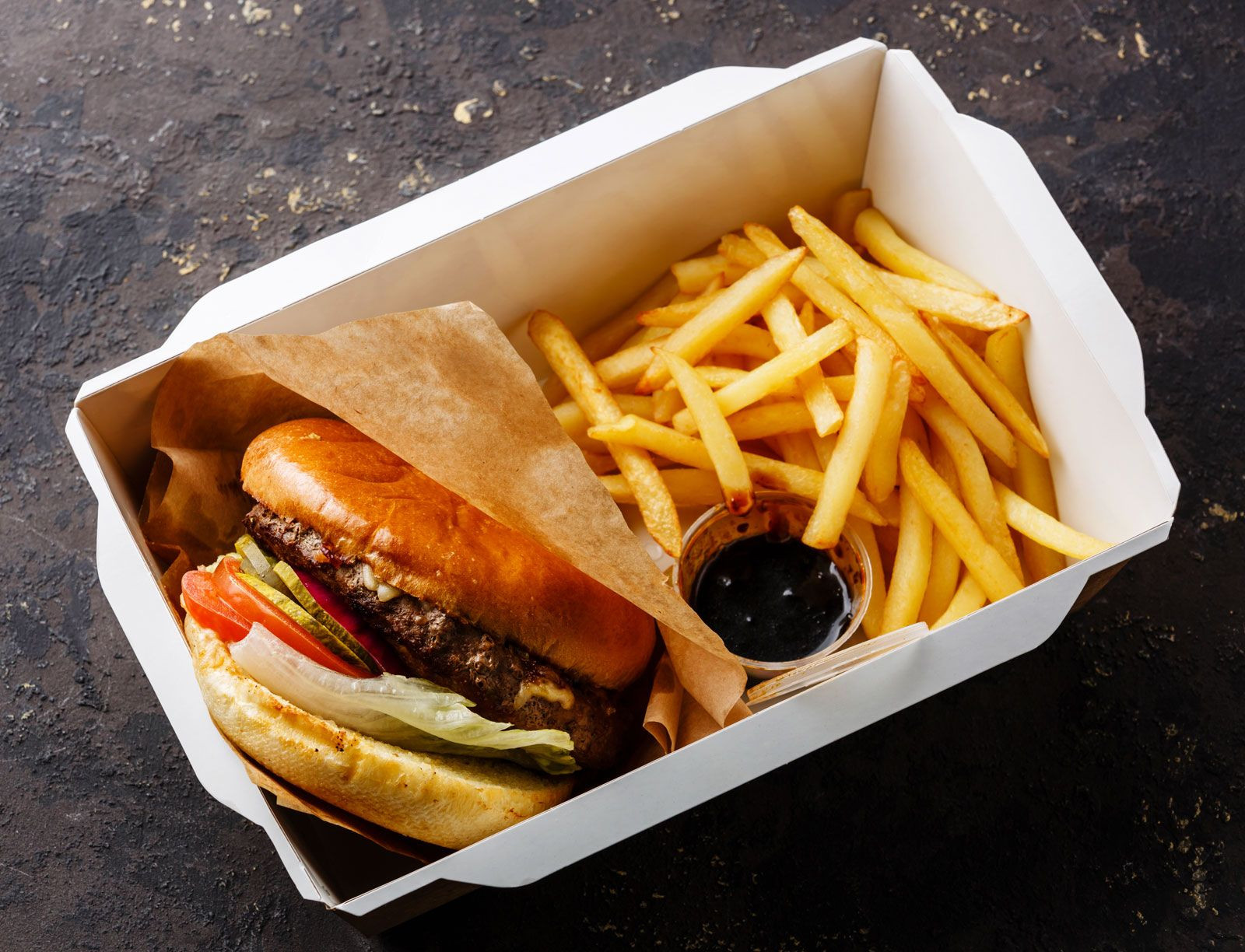Fast food is defined as mass-produced food designed for speed of preparation and delivery. It’s a cornerstone of modern convenience, available across various outlets including restaurants, concession stands, and convenience stores. The hallmark of fast food is its association with chain restaurants like McDonald’s, Burger King, and Taco Bell, which prioritize quick service through take-out and drive-through options. This emphasis on speed and accessibility makes fast food a ubiquitous part of contemporary dining culture.
 Iconic fast food meal of a hamburger with sesame seed bun and golden french fries served in a takeaway box
Iconic fast food meal of a hamburger with sesame seed bun and golden french fries served in a takeaway box
The range of fast food is broad, encompassing popular items like hamburgers, hot dogs, french fries, pizza, tacos, burritos, salads, and sandwiches. These menu items are engineered for rapid assembly and are often pre-prepared, cooked in advance, or frozen to ensure consistency and speed of service. While convenience and affordability are key draws, fast food often faces criticism regarding its nutritional value and production methods.
Historically, the concept of fast meals is not new. Evidence suggests on-the-go eating existed in ancient Pompeii. In the early 20th century, Automats and “smash-and-grabs” offered quick food service, catering to busy individuals. The first White Castle in Wichita, Kansas (1921), is often cited as the original American fast-food chain, popularizing the five-cent burger and pioneering assembly-line efficiency in food service.
The fast-food industry experienced significant growth post-World War II, aligning with suburban expansion and the development of highway infrastructure. Drive-throughs evolved from drive-in restaurants, offering a more efficient model for businesses and greater convenience for customers. In-N-Out Burger is credited with introducing the modern drive-through with two-way speakers in 1948. By the 21st century, the industry had exploded, with hundreds of thousands of restaurants in the U.S. and major corporations extending their reach globally. In 2021, US fast-food revenues exceeded $250 billion, highlighting its massive economic impact.
Technological advancements continue to shape the fast-food experience. Self-order kiosks are now common, streamlining ordering and payment processes while potentially reducing labor costs. Furthermore, third-party delivery services have amplified convenience, extending fast food’s reach beyond traditional restaurant settings.
However, the immense scale of the fast-food industry brings forth criticism. Major chains are enormous purchasers of agricultural products, influencing industrial livestock production and raising concerns about factory farming practices, animal welfare, and environmental sustainability, particularly regarding carbon footprint. Some companies are responding with initiatives to mitigate emissions within their operations and supply chains.
Fast food’s prevalence in urban areas is also linked to the issue of food deserts, especially in low-income neighborhoods with limited access to fresh, nutritious food options. Convenience stores in these areas often stock fast food items, contributing to reliance on these less healthy options. This reliance is associated with increased risks of serious health conditions like heart disease and diabetes, disproportionately affecting residents of food deserts.
The link between fast food consumption and rising obesity rates, especially in the United States, is a major concern. Morgan Spurlock’s documentary Super Size Me brought significant public attention to the negative health effects of a diet exclusively based on fast food. In response to such scrutiny, many fast-food chains have made efforts to remove trans fats and introduce healthier menu items, including salads and fruit, although the core offerings remain calorie-dense and processed.
Labor practices within the fast-food sector also face criticism. Low wages, limited benefits, and challenging working conditions are common issues. The reliance of many fast-food workers on public assistance programs has sparked debate about whether taxpayers are subsidizing the industry. Despite these criticisms, and attempts at unionization, fast food remains a dominant force in the global food industry, constantly adapting its service models and marketing strategies. Terms like “quick-service restaurant” and slogans emphasizing “fast-crafted” or “fan food, not fast food” reflect the industry’s attempts to refine its image while maintaining its core principles of speed and convenience.

